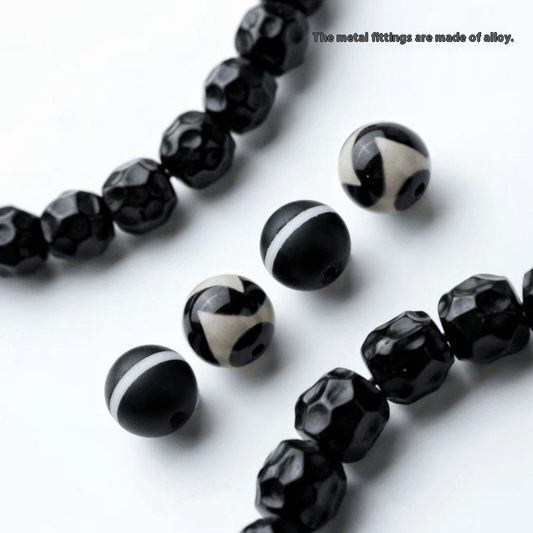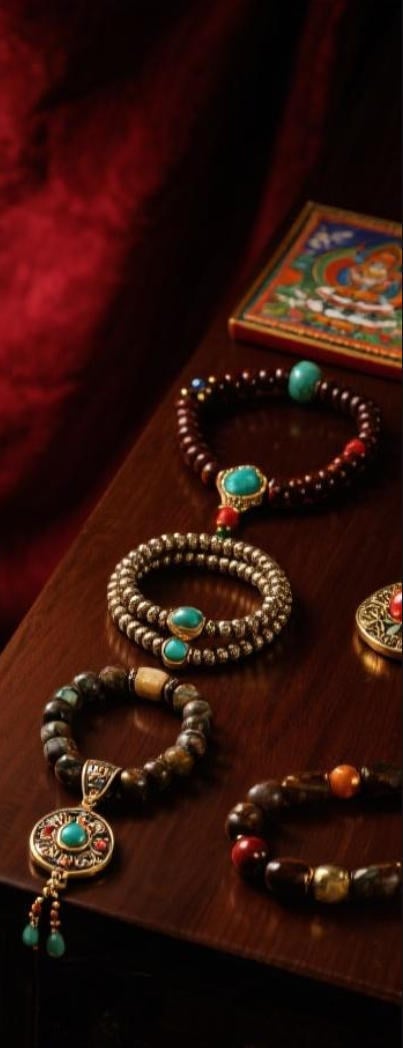warmly crafted Buddhist jewelry with symbolic meaning?

Within the intricate fabric of Tibetan Buddhism lie two compelling artifacts: the artistic thangka and spiritual bodhi gem. Each, uniquely expressed, facilitates linkages to metaphysical clarity. The thangka, a decorative panel, renders enlightened figures, ritualistic patterns, or sacred legends, acting as a focus for contemplative thought.
On the other hand, the bodhi bead, often crafted from fine gems, grain, kernels, or skeletal fragments, is a tangible reminder of Buddha's nirvana under the bodhi tree. Clutching the beads in contemplation anchors consciousness.
- As a pair, the thangka and the bodhi bead illustrate the synergy between expression and belief. They offer a tangible link to the eternal truths of Tibetan Buddhism.
Narratives Engraved on Camel Fragments
Over ancient epochs, timeless treasures whisper tales to a world long passed. These are not luxurious objects associated with neglected empires, but unassuming camel bones etched with motifs that unlock the secrets of a bygone generation. Every fragment holds the echo in a life lived, a journey pursued, and a connection to the hallowed wisdom which encompasses us all.
- It
- Elements
- Act as
Decoding the Spirituality of Thangka Artworks
Tangkas are vibrant paintings on canvas, meticulously crafted by Tibetan artists to depict consecrated figures and scenes from Buddhist doctrines. Each detail within a thangka is laden with significance, forming a complex tapestry of visual narratives that guide the viewer on a reflective journey. The hues used in thangkas are not merely aesthetic choices but carry essential connotations, embodying different aspects of the Buddhist doctrine. From the peaceful figures to the intricate patterns, thangkas offer a view into the rich world of Tibetan Buddhism, inviting us to deliberate upon its enlightenment.
- Ancient thangka art often depicts key Buddhist figures such as Buddha Shakyamuni, Bodhisattvas like Avalokiteshvara and Manjushri, and enlightened beings from various sects of Tibetan Buddhism.
- Across these representations lies a wealth of awareness that can be comprehended by those who engage the symbolic language of thangkas.
Enlightened One's Path to Enlightenment: Embodied in Beads and Bone
Upon the winding way to liberation, the Buddha adopted signs imbued with profound depth. Individual bead and material held within them the spirit of his instruction, presenting glimpses into the mosaic of reality. Through their form, the Buddha articulated profound concepts that elude the realm of physical perception.
From his prayer beads, crafted from valuable materials, radiated vibrations that matched with the delicate currents within. The bone of a being, meticulously transformed into relics, served as tangible signals of the impermanence intrinsic to all existence.
Thangkas: Windows into Himalayan Spirituality
Thangkas brilliant paintings on cloth serve as potent representations of Himalayan spirituality. These intricate works of art, meticulously created with delicate brushstrokes, depict a vast array displaying Buddhist deities, mandalas, and scenes from venerable scriptures. Each thangka is a spiritual map for meditation and contemplation, offering wisdom into the refined teachings of Buddhism.
- They are often used in ritual ceremonies as part of
- manifesting states of spiritual transcendence.
- Thangkas function as not merely decorative creations but rather gateways into the rich and intriguing world of Himalayan spiritual traditions.
The Allure of Bodhi Beads: Exploring Mindfulness and Compassion
Each pellet on a bodhi bead mala whispers tales of ancient wisdom, guiding us on a quest through the tranquil waters of mindfulness. As we handle these intricately crafted beads, our fingers trace the contours of individual one, anchoring our alertness in the present moment. The gentle weight of the beads against our palms serves as a tangible reminder to exhale, fostering a sense of stillness.
- With every bead that passes between our fingers, we foster compassion, extending it first to ourselves and then outward to the world.
- Oriental wisdom teaches us that mindfulness is a art form that requires patience and perseverance.
Using the rhythmic repetition of mantra or simply the mindful tallying of the beads, we break free from the relentless chatter of the mind.
The practice involving bodhi beads is a subtle invitation to renew our connection with ourselves and the world around us.
Unleashing Intention: Creating a Camel Bone Bracelet for Enlightenment
Resolve forms a significant motivator in our lives, shaping our experiences and guiding us towards our intended direction. When we combine this intention with the venerable truths of crafting a camel bone bracelet, we create a potent synergy that can boost our spiritual growth.Camel bone exudes mystical power, representing sturdiness. Its natural beauty and vintage attractiveness serve as a constant reminder of the fundamental dynamic within each of us.As we carefully select each bone, infuse our intentions into the bracelet. With every knot or fastening, we entwine our hopes, dreams, and aspirations for spiritual evolution. This act of creation becomes a sacred ritual, blending us with our inner wisdom and guiding us on a expedition of realization.- Let the natural hues and textures of the bone guide your vision.
- Feel the energy flowing through your hands and into the creation.
- Bless the bracelet in ceremonies to infuse vitality.
Camel Bone and Buddhist Symbolism: A Legacy of Meaning
In the rich tapestry inside Buddhist tradition, artifacts often hold profound symbolic meaning. Amidst these varied objects, camel bone stands out as a peculiar and compelling element. Amid history, this material has been integrated in the crafting across various Buddhist objects, each imbued with specific connotations.
- Considered as a symbol of resilience and strength due to the camel's ability to endure in harsh environments, camel bone often exemplifies spiritual fortitude.
- Complementarily, the color and texture of camel bone are believed through some to hold auspicious connotations, signifying purity and serenity.
Thereupon, camel bone has become a meaningful part of Buddhist folklore, serving as a tangible link to the profound teachings of this ancient faith.
Thangka Works: Stories of the Divine
Within the ethereal realm of Tibetan Buddhism, Thangka paintings emerge as sacred portals to enlightenment. These breathtaking works, meticulously crafted by skilled artists known as thangkapa, depict a myriad embracing vibrant deities, celestial beings, and mythical creatures. Each brushstroke infuses profound spiritual significance, narrating ancient tales and philosophical concepts.
- Presenting a vast reservoir of Buddhist iconography, Thangkas serve as both devotional objects and instructional tools. Dedicated practitioners gaze upon these paintings during rituals and meditations, seeking to develop spiritual wisdom.
- Elaborately embellished with intricate details through a plethora of vibrant hues, Thangkas are considered windows into the divine. The painting acts as a symbolic representation of the Divine Figure's teachings and the path to liberation.
Using their compelling imagery and symbolism, Thangka paintings offer a glimpse into the rich devotional traditions of Tibet. They are a testament to the enduring charm of Tibetan art and its profound ability to illuminate.
Embracing the Duality: Thangkas and the Cycle of Life and Death
Thangkas, these vibrant woven scrolls from Tibet, offer a profound reflection on the transient nature of existence. Each intricate portrait depicts deities and beings engaged in the unceasing cycle of life and death, a assemblage of birth, growth, impermanence, and transformation. The artists skillfully combine these concepts within the thangka's setting, highlighting the harmony of all things. Through vivid representations, they invite us to contemplate on our own being. The cycle circulates, a dance of coming and going, highlighting the preciousness of each moment. By embracing this duality, thangkas teach us to acknowledge the beauty in both life's joys and sorrows.Bonds of Serenity: The Significance of Bracelets in Buddhist Practice
In the intricate tapestry of Buddhist practice, seemingly basic objects often hold profound meaning. Among these are bracelets, which serve as tangible indicators of devotion and commitment to the journey of Buddha. Worn on the wrist, a bracelet works as a constant reminder of one's aspirations and dreams. It can represent the impermanence of life, prompting practitioners to remain rooted in the present moment. Some bracelets may possess sacred characters, such as mantras bracelet or the names of Buddhas, which are regarded to generate positive energy and shield. Others are sometimes made from components with spiritual significance, like sandalwood or lotus seeds, amplifying the bracelet's energy. Ultimately, the significance of a Buddhist bracelet rests far beyond its physical form. It becomes a powerful tool for reflection, a inspiration to live in harmony with the teachings of Buddha, and a wellspring of one's unwavering belief.